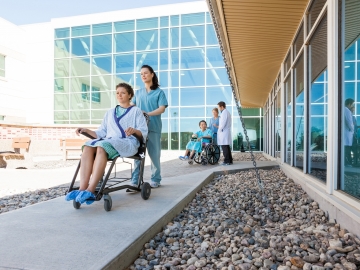The profound world of robotics that imagines the future of humanity and society
Why does it have to be humanoid? Since research began by the late Professor Ichiro Kato about 60 years ago, the development of humanoids (humanoid robots) originating in Japan has continued to progress as if in response to questions from all walks of life. Waseda University was the starting point for this, and has led the world in research while combining the wisdom of industry and academia. Professor Atsuo Takanishi, Director of Humanoid Robotics Institute, looks back on the past.
◆Waseda University pioneers the forefront of humanoid robots
──Waseda University has been a world leader in humanoid (humanoid robot) research. Please tell us about the history of this project.
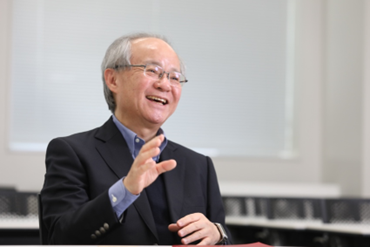
Atsuo Takanishi (Director/Professor, Faculty of Science and Engineering)
The first research into humanoids began at Waseda University in the late 1960s under the leadership of the late Professor Ichiro Kato, who pioneered robotics in Japan. The interdisciplinary “WABOT Project” was launched in 1970, and in 1973 the world’s first bipedal humanoid robot, “WABOT-1,” was completed. In 1984, the piano-playing “WABOT-2” was released, and was exhibited at the Tsukuba Science Expo the following year. These two robots are still on display in Building 63 on the Nishi-Waseda Campus.
I first came into contact with robotics in Professor Kato’s laboratory in 1977. I was a student in the Faculty of Science and Engineering. I then went on to graduate school and continued my research under Professor Kato, where I witnessed the creation of a succession of robot systems incorporating new elemental technologies. These included “WABIAN,” a bipedal robot that can be connected to a network; “WT,” a talking robot that reproduces the human vocalization mechanism; and “KOBIAN,” which expresses human-like emotions using its entire body.
The movements of early humanoids were of course awkward and crude compared to today’s cutting-edge technology, but there is no doubt that it was an innovative challenge that was unprecedented in the world. Professor Kato passed away in 1994 leaving behind a great legacy of accomplishments, but we have inherited his legacy and have produced many fundamental technologies related to humanoids and many talented people who support them. Humanoid Robotics Institute was established in April 2000. The spirit of pursuing a new relationship between humans and machines in an advanced information society has been steadily passed down to the current Humanoid Robotics Institute, which was newly established as Project Research Institute in 2020.
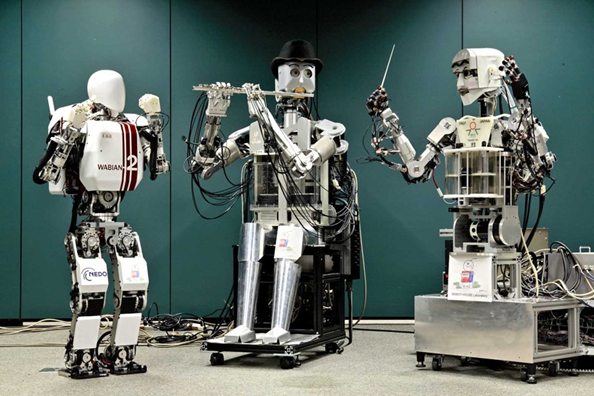
Since the 1970s, Waseda University has been the starting point for the creation of a wide variety of humanoid robots.
──The 1960s was the era of “Astro Boy.” What meaning did you seek in having a robot that was “human-like”?
At that time, Japan was in the midst of a period of rapid economic growth, and the manufacturing industry was beginning to grow at a rapid pace. Engineering technology was advancing, and factory productivity was steadily increasing through automation. The manufacturing industry would likely continue to grow in this way. So, what would be the next technology and field to which it could be applied? When Professor Kato thought about this, he says that he focused on the service industry.
The service industry is carried out by humans. To develop the technology, it was necessary to elucidate from an engineering perspective how the human body moves and how we use our five senses. However, there was no such prior research anywhere in the world. So, we decided to create our own “humans.” That was the starting point.
At that time, industrial robots that could replace the movements of human hands and arms were already beginning to appear, but feet and legs had yet to be developed. So, first the movements of the hip joints, knees, ankles, etc. were reproduced mechanically, and then these were lined up side by side to create a prototype of bipedal walking. The upper body was then connected to this to integrate the whole. This was the process that progressed in humanoid research.
◆Towards a society in which humans and robots coexist
──Since your research is based on bodily movement and emotions, it seems likely that the related issues and themes will be quite diverse.
That’s right. At first, the research started with applications in the service industry in mind, but as we continued to explore the topic, the approach broadened to include understanding humans themselves from the perspective of robotics. This required not only an engineering perspective, but also a scientific one. Humanoids as a tool for studying humans scientifically. I remember Professor Kato saying something like that. He later played a role in the establishment of School of Human Sciences at Waseda University.
Humanoids are robots that have the same behavioral patterns as humans and aim to coexist naturally with humans while working in the same living space as humans. They must be useful in a wide range of areas closely related to daily life, such as housework, nursing care, sports, and entertainment. This is why collaboration with all academic fields related to humans, including not only engineering but also biology, psychology, medicine, and sociology, is required.
──The appearance of ASIMO, the bipedal robot that Honda announced in 2000, was an event that foreshadowed such a future.
This was one of the catalysts that helped humanoids become more widely recognized in society. Honda had previously announced prototypes called “P2” and “P3,” which attracted attention from researchers around the world. In the 1990s, such companies also became more active in developing robots, and Sony released the pet robot “Aibo” in 1999, followed by the humanoid “Qrio” the following year. In fact, a Waseda research team was also approached during the development process, and I often visited the Sony research lab where my seniors from the Kato Laboratory worked. I am truly grateful for this collaborative research with such a forward-thinking company, and even now I feel overwhelmed with gratitude when I think back on it.
Until around the 1980s, the world’s view of humanoids was harsh, and many people thought it was unthinkable that humanoid machines would become part of the real world. When I was a student, I was even asked why I was researching something that was useless. They said that there was no need for bipedal robots, and that wheels and caterpillars would be fine.
However, as we all know, humanoids are now attracting attention from all over the world, and huge amounts of capital from the US and China are being invested in their development. They are also expected to play a role in training and rehabilitation. Have you heard of “RoboCup”? It is a competition between autonomous mobile robots, and the goal is to compete against the world soccer champion team by 2050. The idea is spreading to various fields, to the point where such dreamlike stories are being born.
◆ The endless possibilities for using robots in sports, medicine, agriculture, and more
──Professor Takanishi, what kind of research have you focused on?
We have conducted research from the following two perspectives.
1) “Robotics and Human Science” involves designing and creating humanoids that mimic human form and functions, and using them to reproduce human actions, behavior, and functions, both physically and mentally, to build an engineering model of humans.
2) “Human-Model-Based Robotics” aims to develop a deductive design theory for robot systems that involve humans, such as those in the fields of medicine, welfare, disaster response, and educational support.
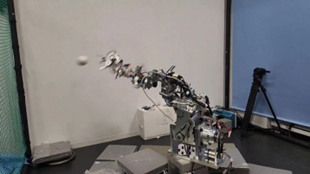
A robotic upper body developed for pitching research
There are too many specific themes to list in detail, but to give some easy-to-understand examples, we are conducting research and development on sports training, medical education, agricultural work support, etc. These correspond to the activity themes of Project Research Institute over the past five years.
First, in the field of sports, we are conducting experiments using humanoids to change the magnitude and speed of movement, aiming to reproduce basic athletic movements such as throwing, jumping, running, and lifting heavy objects. Specifically, we are developing a robotic upper body that enables pitching a ball. We have reproduced the mechanism of pitching, which makes use of the twist of the waist while effectively using the elasticity of the shoulders and the swing of the arms to transmit energy from the trunk to the fingers. By collaborating with sports science researchers, this type of research could be used to train super athletes, such as Shohei Ohtani.
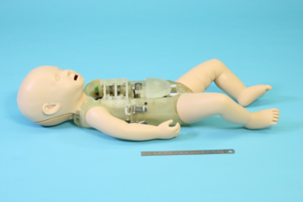
Neonatal resuscitation training system highly praised by the Japan Robotics Society
In the medical field, we are developing patient robots that can be used to train clinical procedures, and are researching ways to provide trainees with feedback on the movements, perceptions, and intentions of experts. This will also lead to the reproduction of cases using robots and the evaluation of procedures. For example, there is a method of neonatal resuscitation in case of emergencies when pregnant women give birth. We developed a training system for this method, and received the Excellent Presentation Award (2020) and Excellent Research Award (2021) from the Japan Robot Society.
In the agricultural field, we have started a project to utilize robots to grow crops in the hollow spaces beneath solar panels, achieving both CO2 absorption through greening and energy production. We are conducting basic research into the technology that will enable robots to autonomously navigate along the furrows of fields, recognize and pick crops, and separate out weeds.
──There are also robots that have been commercialized through collaborative research with companies and are now on sale.
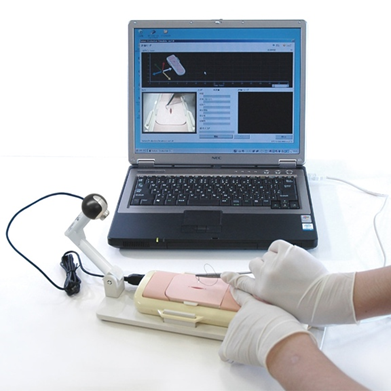
A suture technique evaluation simulator commercialized by Kyoto Scientific (Image provided by Kyoto Scientific Co., Ltd.)
Yes. There are many such cases, especially in medical education. Originally, we were developing surgical robots that could be used for treatment itself, and Japan was a world leader in that field, but unfortunately, the reality is that we are now lagging behind Europe, the United States, and China. In Japan’s case, we tend to be slow to develop social systems, so even if we start well, it takes time to implement it in society, and before we know it, we’ve been overtaken by other countries. So at one point, we decided to use it for education.
The first product we worked on was a suturing technique evaluation simulator for surgical operations. Suturing after surgery involves a series of needle threading and tying, and it takes a great deal of training to be able to do it like an experienced surgeon. We thought it would be useful to have a machine that allowed medical students to practice on their own and receive evaluations, so we developed it together with Kyoto Kagaku, a company known for its medical and nursing education materials. Sensors are embedded in a material that mimics human skin, and the level of skill can be measured and evaluated while practicing a technique. This was commercialized about 10 years ago, and is still sold by the company today.
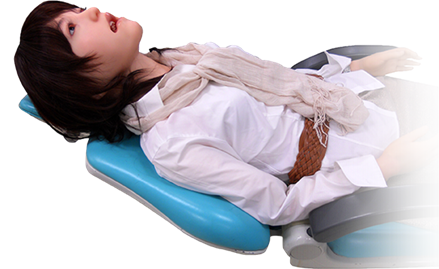
Dentaloid sold by Tmsuk (Image provided by Tmsuk Co., Ltd.)
There is also Dentaroid, which was developed for dental students’ practical training. It is a patient robot. It has a voice recognition function and opens its mouth and turns its face according to instructions. It is a simulator that can reproduce the patient’s coughing and reflexive vomiting. This was commercialized by Tmsuk Corporation, with the cooperation of Showa University and Kogakuin University, based on patented technology of Okino Kogyo Robotics.
◆WASEDA’s people and technology active in academia and industry
──Through collaboration with a variety of researchers, experts, and companies, the scope of applications for humanoid robots is expanding.
That’s right. There was a time when I was criticized harshly, but as I continued to work hard and continue my research, people like this started to approach me, and gradually my circle of friends increased. I think that Professor Kato in heaven would be satisfied. I still meet with the people who have shared the hardships with me several times a year and exchange opinions over meals. I look at the trends in the world and wonder what kind of robots will be needed in the future.
Are you considering any new developments?
I will soon be retiring and closing my lab, but researchers who will take over from me are steadily growing. Many people have come here from abroad to study and start new things. One of these is a venture company called LP-RESEARCH, which was started by Chinese and German students after they graduated. They are developing sensing systems for use in fields such as VR (virtual reality) and AR (augmented reality). Lin, Jia-Yeu, who is here with us now, is from Taiwan and earned his doctorate in research on humanoid saxophone-playing robots. He is now a lecturer in the School of Creative Science and Engineering.
I would be delighted if this talented young generation could use their expertise to develop new technologies that will benefit society. Research on humans and society is essential for this. Discoveries made there will lead to ideas for new machines. For example, a bipedal robot chair to replace wheelchairs, or a disaster response robot to help in disaster-stricken areas. I hope that the government will quickly move forward with creating systems to incorporate these technologies into the real world.
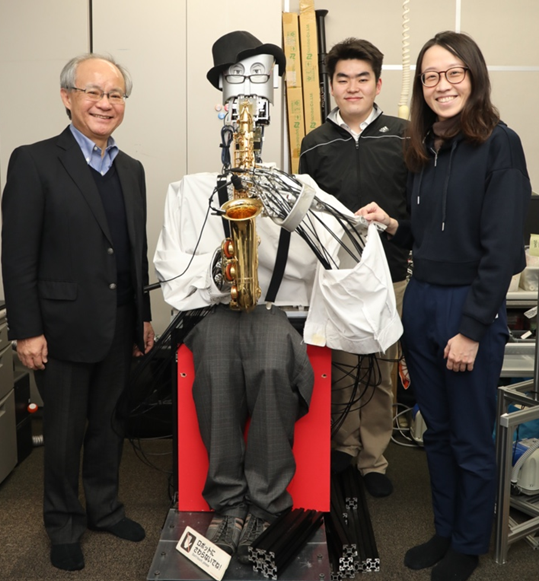
With the humanoid saxophone-playing robot born from the Takanishi Laboratory. From the right: Faculty of Science and Engineering lecturer Hayashi Kayu, who continues the humanoid research, and second-year master’s student Kuniya Daiki.


